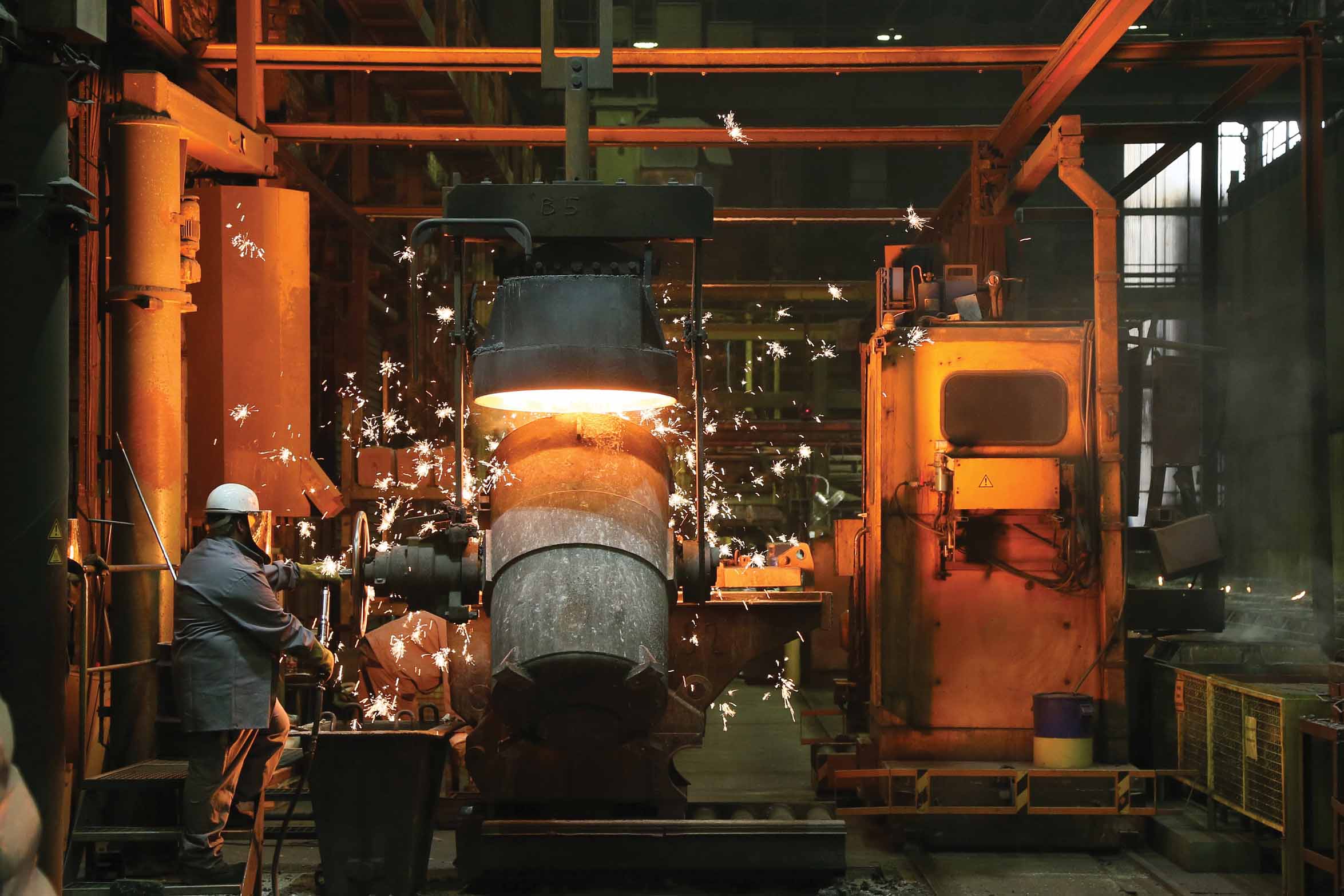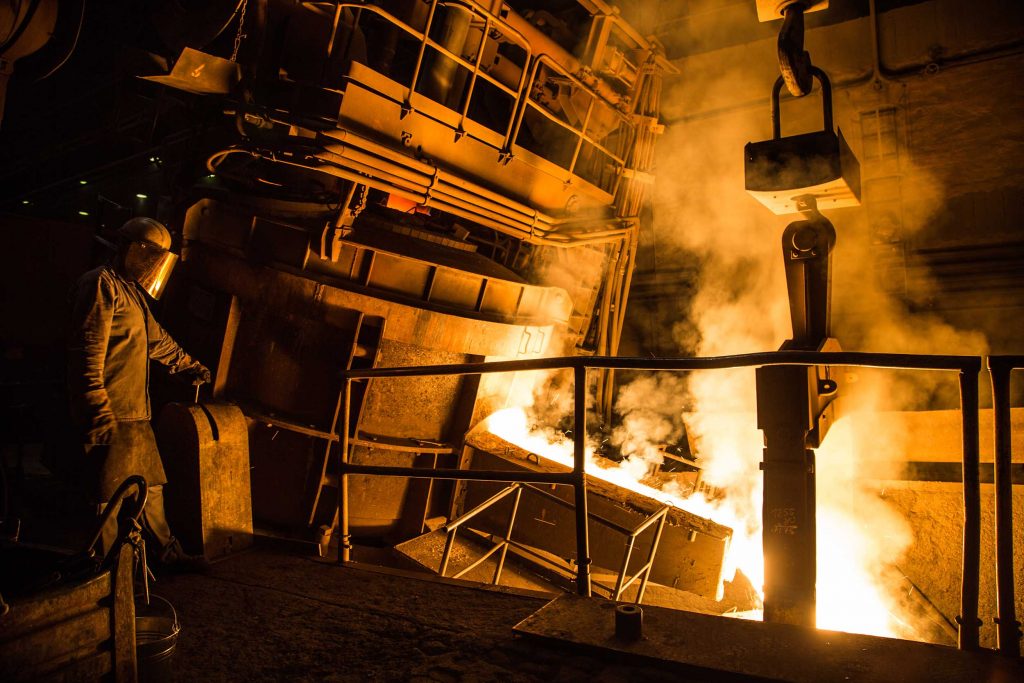
Castings are indispensable to sustainable and climate-neutral manufacturing. There is no sector of industry that could do without cast components of iron, steel or NF-metals ranging from aluminium to zinc. For export sectors such as automotive and machine tool production the foundry industry is a key sector within their value chains. However, the foundry industry – with its just under 600 companies of a wide variety of sizes, manufacturing products for most different markets with the most diverse metal materials and casting technologies – is an energy-intensive and therefore high-CO2 emission industry. As varied as the foundry industry is, as diverse and different must the paths towards climate-neutrality be for its individual enterprises – be it with green power or hydrogen, bio coke or biogas. New decarbonization technologies and approaches will be centrestage at the trade fairs decarbXpo 2022 in September and especially for foundries at GIFA 2023 in Düsseldorf.
The foundry industry is a heterogeneous sector. The approximately 600 foundries with their around 70,000 employees are predominantly SMEs ranging from small commercial bell founders with under 10 employees to multi-national automotive OEMS. Enterprises not only vary widely in size and corporate structure, in their consumer industries and sales markets – they also vary in terms of the processes applied and metals used. The German foundry industry generates to the tune of € 12 billion sales annually and is considered leading in Europe. Despite its comparatively small size this sector is a crucial supplier of key components for the value chains in the industrial site that is Germany. Foundry industry products are must-haves – from filigree pressure die-cast zinc parts for medical devices and structural aluminium components for lightweight automotive construction to the heavy ductile iron components needed for wind turbines weighing several tons each.
However, there is one common denominator for all foundries: they are energy-intensive operations. Be it iron, steel, light or heavy metals, be it pressure-die casting, low-pressure, or gravity die casting: before metals can be poured into moulds or dies, they have to be molten and the melt must be held at a specific temperature for the duration of pouring – by means of coke, gas or power. Add to this, heat treatment of the solidified castings, which allows the desired component properties to be set in a targeted manner.
For years now the high energy prices have caused companies in Germany problems and these insecurities have dramatically increased with the war in Ukraine. The prices for power, coal and natural gas have risen markedly and there is no end to this trend in sight – gas scarcity becomes an existential threat. Against this backdrop the obligation to reach climate-neutrality not only means extra costs but a burden hard to bear in view of average profit margins of around 4%.
What is to be done? There is no such unambiguous transformation path for the foundry industry as for the steel sector – direct reduction powered by green hydrogen plus green electricity. “Each foundry has to develop its own concept for climate neutrality,” says Elke Radtke, Environmental Protection and OSH Officer at the German Foundry Association BDG. “What counts for foundries is a reliable political framework – because the changeover to another melting technology is a decision taken for decades.”
Decarbonisation: all industries exploring all avenues
“Foundries are more than prepared to tackle the transformation to climate-neutrality,” says Dr. Ingo Steller, Managing Director of Foundry Technology Research Association and Expert for Iron and Steel Casting, Manufacturing Technology at BDG (German Foundry Association). However, many decarbonisation projects involving bio-coke and hydrogen, he knows, are still in the research phase requiring multi-annual operational trials. Study subjects include technologies for CO2-avoidance such as in the BDG’s InnoGuss project. Initial, viable results are expected by the middle of next year.
In foundries CO2 is emitted by a wide variety of units in a host of processes. Decarbonisation / Defossilisation is therefore not limited to iron casters’ coke-fired cupolas but also nonferrous metal casters’ natural-gas fired furnaces as well as most holding furnaces and preheaters. Qualifying as green energy alternatives next to green power are, above all, bio-coke, biogas and hydrogen. But here supply alone poses a major problem: all energy-intensive sectors are exploring all avenues – biomass, biogas and hydrogen as a replacement for natural gas and coal.

Iron foundries
Iron foundries in Germany melt over half their grey iron using coke-fired cupolas and around 40% with electric induction furnaces. This is why electric melting is the only solution to reduce CO2-emissions to net zero by 2050 in the opinion of many casting experts. The leading induction furnace producers ABP and Otto Junker will be exhibiting the latest crucible furnaces at GIFA 2023 – medium-frequency crucible induction furnaces suitable for both cast iron and steel castings.
So substituting coke-fired cupola furnaces by electric smelting is possible and has all the arguments in favour of it from the viewpoint of CO2-neutrality – subject to green power; but this is precisely the problem. In Germany power from renewable sources will not be available in sufficient quantities in a long time all the more as major consumers have already secured nearly all available green power contingents. It is therefore difficult for iron foundries to become climate-neutral by means of electric melting. Rising power prices and insecure conditions are associated with additional investment risks. The target of climate neutrality by 2050 is set but the path towards it is still open.
There is also another drawback to crucible furnaces compared to the coke-fired cupolas that are cheaper in initial investment and operation. With their sophisticated metallurgy and optimised furnace campaigns iron casters in Germany can even turn the lowest-quality scrap into a melt for high-quality cast iron turned into top products for the world market: for example, both thin-wall and high-strength cast iron engine blocks for the automotive industry that are as lightweight as comparable aluminium products. Crucible furnaces, on the contrary, require the best scrap the market has to offer. And this is increasingly secured by the major steel mills that depend on high-quality scrap as a result of changing over from blast furnace to electric steel production. The Salzgitter steel mill, for example, has agreed with its buyer Volkswagen on a closed-loop cycle for steel between the factories in Salzgitter and Wolfsburg; the world’s largest steel producer ArcelorMittal buys up scrap recycling companies – huge amounts of waste metal that are no longer available to the free market and which can put smaller buyers like foundries in a fix. What’s more the changeover from cupola to crucible furnaces alone is only part of the equation – representing millions of euros for a medium-sized crucible furnace. Additional investment required includes the transformer and power line, let alone the costs for rebuilding and the associated losses caused by production standstill.
Biocoke as an alternative
Biomass could provide a bridge technology for cupola furnaces even though the operational trials are not yet concluded. Made of renewable raw materials biocoke can already contribute to decarbonization when admixed to coke. However, cupolas are still a long way from using 100% biocoke. Challenges for foundries are many and varied here. There is no regional supply of biomass. At present supplies are predominantly covered by imports. However, the carbonization of biomass is also far from foundry practice in technical terms. “Biocoke is a hope but not put into practice yet,” says Steller of BDG who explains that little more than 10% of biocoke can be admixed to the charging materials for cupolas. “For the production of foundry biocoke waste tree trunks have to be carbonised and compacted with a binder into mechanically stable, high temperature and pressure-resistant briquets of a sufficient size – and all of this on an industrial scale and at competitive prices.” The small pieces of biocoke used in the steel industry are not suitable for use in foundries.
Hopes rest on hydrogen
Hydrogen might be another option for the future. This option is discussed by Pascal Kwaschny and Hans-Jörg Meißner of hydrogen producer Linde in an expert article on “Concepts for Reducing CO2-Emissions in Foundries by Using Hydrogen” (in the magazine ‘Prozesswärme’ 01/2021) who state the use of hydrogen in combustion in foundries can as a rule contribute to a significant reduction of CO2 emissions. This applies especially, they report, to downstream equipment such as a natural gas substitute for NF-metal pre-heating ladles. Likewise, innovative concepts, where waste heat is used as energy to produce the required hydrogen, might play a part in future for cupola furnaces.
The use of hydrogen in foundries is still a young research field and not an option for cupola furnaces from today’s perspective according to estimates by foundry experts like Ingo Steller. “More investment and research are needed for this,” says Steller. There are some burner tests showing that such burners could work, but according to Steller these cannot be transferred in a 1:1 scale. “There are no practical tests with cupola furnaces yet; it is not yet known how these burners with their higher temperatures would work with the charge make-up as found in a cupola.”
Steel foundries – green power for decarbonisation
Steel foundries melt high-quality steel scrap exclusively using thermal energy from power in electric arc furnaces (EAF) – smaller but similar to the electric furnaces used in the steel industry – and increasingly also in induction furnaces. Here power from renewable sources is the energy of choice. The liquid steel produced is characterised by its high purity and this can be processed further in secondary metallurgy lines. Often the cast product undergoes heat treatment. If the downstream treatment is done with natural gas, an admixture of and/or replacement by biogas could be one option for decarbonisation.
NF-Metals – biogas or hydrogen
In the NF-metals segment approximately 70 % of the 3,000 to 4,000 melting units in German foundries are fired with fossil fuels, especially natural gas. Here biogas could contribute to decarbonisation as an admixture for natural gas or potentially by replacing it. However, some research and practical trials have to be carried out here. Hydrogen as a natural gas replacement probably qualifies best for pre-heating furnaces; the research needed here is comparable to that for hydrogen use in cupolas. Inductive heating has not undergone a great deal of testing here and faces similar challenges as the use of crucible induction furnaces in melting operations.
Foundries seeking paths towards climate neutrality
Flagging up transformation pathways for CO2 reduction is the aim of the InnoGuss research initiative by BDG. With a roadmap for climate neutrality experts from the association, research and industry are already studying technologies from other energy-intensive sectors as steel mills or burner layouts from glass production. “The aim is to find out which technology can be adapted for foundries,” says technology expert Steller. InnoGuss is scheduled to run until the middle of next year, probably even longer. Then it will be up to plant manufacturers to deliver.
First breakthrough technologies for decarbonisation are expected by foundry experts at decarbXpo 2022, the new trade fair for technologies and solutions for decarbonising the industry to be held by Messe Düsseldorf in September this year. This theme holds great relevance across the industry and many challenges are comparable across sectors. “Especially in terms of natural gas substitution and pre-heating I do expect to see quite a few things from furnace manufacturers – technologies from decarbXpo, which can be adapted to GIFA,” says foundry expert Steller.
The international foundry trade fair GIFA 2023 will be held concurrently with METEC, THERMPROCESS and NEWCAST as the trade fair quartet GMTN 2023 as part of the “The Bright World of Metals” in Düsseldorf from 12 to 16 June 2023.
Author: Gerd Krause, Mediakonzept, Düsseldorf